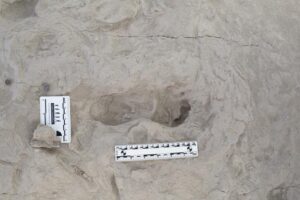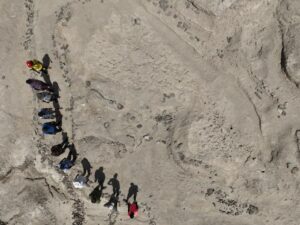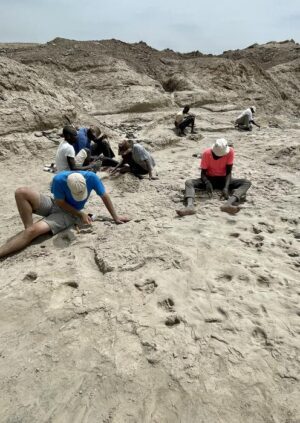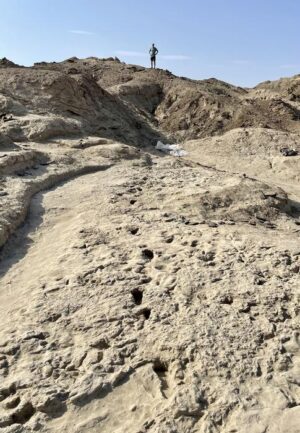 A footprint hypothesized to have been created by a Homo erectus individual. Kevin G. Hatala
A footprint hypothesized to have been created by a Homo erectus individual. Kevin G. Hatala American Association for the Advancement of Science (AAAS)—Newly discovered footprints show that at least two hominid species were walking through the muddy submerged edge of a lake in Kenya’s Turkana Basin at the same time, about 1.5 million years ago. The find from the famous hominid fossil site of Koobi Fora described by Kevin Hatala and colleagues provides physical evidence for the co-existence of multiple hominid lineages in the region—something that has only been inferred previously from overlapping dates for scattered fossils. Based on information on gait and stance gleaned from the footprints, Hatala et al. think that the two species were Homo erectus and Paranthropus boisei. This is the first evidence of two different patterns of bipedalism among Pleistocene hominids appearing on the same footprint surface. After examining the new Koobi Fora footprints, the researchers analyzed other similar-age hominid footprints and conclude there is a distinct pattern of two different types of bipedalism across the East Turkana region. The overall analysis indicates that the different species were contemporaneously using these lake habitats, with varying possibilities of competition or niche partitioning that could have impacted trends in human evolution. William Harcourt-Smith discusses the implications of the footprints in a related Perspective.
___________________________

A footprint hypothesized to have been created by a Homo erectus individual. Kevin G. Hatala
___________________________

An aerial photo of the excavated trackway surface, with members of the research team along its perimeter. Louise N. Leakey
___________________________

A footprint hypothesized to have been created by a Paranthropus boisei individual. Kevin G. Hatala
___________________________

Members of the research team excavating the trackway surface. Neil T. Roach
___________________________

A trackway of footprints hypothesized to have been created by a Paranthropus boisei individual. Neil T. Roach
___________________________
Article Source: AAAS news release.
*Footprint evidence for locomotor diversity and shared habitats among early Pleistocene hominins, Science, 29-Nov-2024. 10.1126/science.ado5275
___________________________
Advertisement

EXPLORE THE ANCIENT ETRUSCANS IN PERSON!
Experience a unique, up-close-and-personal hike among ancient hilltop towns in central Italy. You will walk the sensational countryside of the regions of Umbria and Tuscany, soaking in important sites attesting to the advanced Etruscan civilization, forerunners of the ancient Romans; imposing architectural and cultural remains of Medieval Italy; local food and drink; and perhaps best of all — spectacular scenic views! Join us in this collaborative event for the trip of a lifetime!



